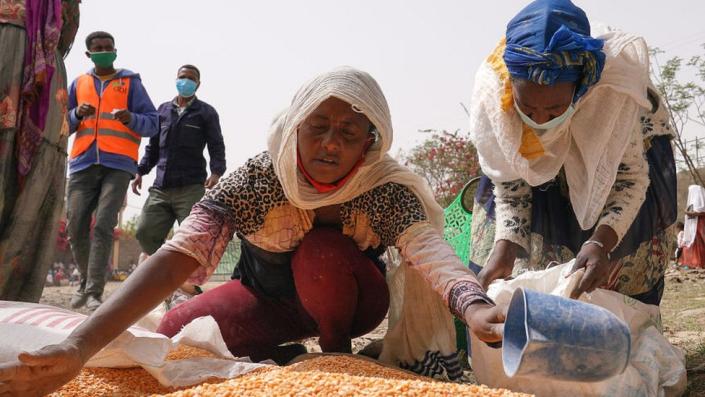
The Ethiopian government and health officials in Tigray say food, basic medicines and equipment are now reaching many in urgent need following the peace deal signed last month.
However, the situation remains very serious across the region. “Critical pharmaceutical supplies are lacking”, says Kindeya Gebrehiwot of the Tigray People’s Liberation Front (TPLF). “Malaria has become epidemic in some districts”.
Aid convoys getting through
For months, the only viable land route into Tigray had been from the Afar region to the east. But even that had been highly problematic with very limited supplies getting through.
Now convoys are able to travel this route more freely, along with two others from the south and further to the west.


The UN says by 8 December, 20 organisations had delivered more than 50,000 tonnes of food items and close to five tonnes of non-food items to Tigray, including medical supplies.
The Ethiopian government has also distributed food aid to some areas in Tigray following what it describes as the improved security situation.


Humanitarian flights to the regional capital, Mekelle, and the city of Shire, have been carrying medical supplies and aid workers.
The UN says seven tonnes of medical supplies were flown from the capital Addis Ababa to Shire in November.
The first movement of aid to arrive in Mekelle after the peace deal was a convoy of two trucks carrying medical aid on 15 November.
Saving lives before anything else!
Our first convoy of aid supplies has arrived in Mekelle. Two trucks delivered medicines, emergency and first aid kits to support health facilities in #Tigray to treat patients with conditions that need urgent care.
More aid in the days ahead. pic.twitter.com/67zWpoX9Ed
— ICRC Ethiopia (@ICRCEthiopia) November 15, 2022
Prior to that, the last movement of humanitarian cargo delivered by the UN into Tigray took place on 22 August along the Semera route.
There was also an airlift of aid on 23 August from the Ethiopian capital, Addis Ababa, to Mekelle.
More than five million people were facing severe hunger in Tigray at that time, according to the World Food Programme.


Problematic aid flows during the conflict
The flow of aid into the Tigray region had been problematic since fighting broke out in November 2020.
There were periods when international aid agencies had access – between July and December 2021 and between April and August 2022.
But there have been months when there’s been only limited or no access for humanitarian aid and staff into the region as the flow is affected by fighting along aid delivery routes, multiple roadblocks and checks and damage to infrastructure.


Delays in issuing approvals for aid convoys to travel by road through areas held by federal and regional government forces had been a key issue.
The government had also put in place strict controls for humanitarian aid flights – including a requirement for all flights to land first in the Ethiopian capital, Addis Ababa, for inspection.
Reconnection to the power grid
In addition to humanitarian aid, large parts of the Tigray region have been without electricity, telephones, internet and banking services.
The government has now reconnected Mekelle to the national electricity grid, raising hopes that electricity supplies will soon be restored more widely in Tigray.
Mobile telephone connectivity has also been restored in some areas, including in Shire, but large parts of the Tigray region remain without power and phone communications.






